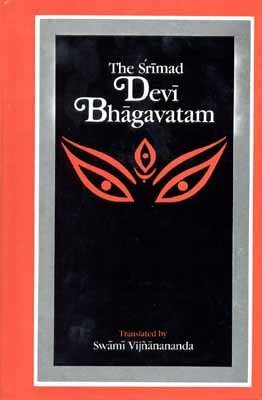The Devi Bhagavata Purana
by Swami Vijñanananda | 1921 | 545,801 words | ISBN-10: 8121505917 | ISBN-13: 9788121505918
The English translation of the Devi Bhagavata Purana. This Sanskrit work describes the Devi (Divine), the Goddess, as the foundation of the world and as identical with Brahman, the Supreme Being. The Devi Bhagavata Purana is one of the most important works in Shaktism, a branch of Hinduism focusing on the veneration of the divine feminine, along w...
Chapter 39 - On the story of Mahā Lakṣmī
1-3 Nārada said :-- “O Lord! I have heard in the discourse on Sāvitrī and Yama about the Formless Devī Mūla Prakriti and the glories of Sāvitrī, all true and leading to the endless good. Now I want to hear the story of the Devī Lakṣmī. O Thou, the Chief of the knowers of the Vedas! What is the nature of Lakṣmī? By whom was She first worshipped? and by what Mantra? Kindly describe Her glories to me.”
4-33. Nārāyaṇa said :-- Of old, in the beginning of the Prākritik Creation, from the left side of Kṛṣṇa, the Supreme Spirit, appeared in the Rāsamaṇḍalam (the Figure Dance) a Devī. She looked exceedingly handsome, of a dark blue colour, of spacious hips, of thin waist, and with high breast, looking twelve years old, of steady youth, of a colour of white Champaka flower and very lovely. The beauty of Her face throws under shade millions and millions of autumnal full moons. Before Her wide expanded eyes, the midday lotus of the autumnal season becomes highly ashamed. By the Will of God, this Devī suddenly divided Herself into two parts. The two looked equal in every respect; whether in beauty, qualities, age, loveliness, colour, body, spirit, dress, ornaments, smile, glance, love, or humanity, they were perfectly equal.
Now she who appeared from the right side is named Rādhā and she who came from the left side is named Mahā Lakṣmī. Rādhā wanted first the two armed Śrī Kṛṣṇa, Who was Higher than the highest; then Mahā Lakṣmī wanted Him. Rādhā came out of the right side and wanted first Kṛṣṇa; so Kṛṣṇa, too, divided himself at once into two parts. From His right side came out the two-armed and from his left side came out the four-armed. The two-armed person first made over to Mahā Lakṣmī the four armed One; then the two armed Person Himself took Rādhā. Lakṣmī looks on the whole universe with a cooling eye; hence She is named Lakṣmī and as She is great, She is called Mahā Lakṣmī. And for that reason the Lord of Rādhā is two-armed and the Lord of Lakṣmī is four-armed. Rādhā is pure Aprā kritic Śuddha Sattva (of the nature of pure Sattva Guṇa, the illuminating attribute) and surrounded by the Gopas and Gopīs. The four-armed Puruṣa, on the other hand, took Lakṣmī (Padmā) to Vaikuṇṭha. The two-armed person is Kṛṣṇa; and the four-armed is Nārāyaṇa. They are equal in all respects. Mahā Lakṣmī became many by Her Yogic powers (i.e., She remained in full in Vaikuṇṭha and assumed many forms in parts). Mahā Lakṣmī of Vaikuṇṭha is full, of pure Sattva Guṇa, and endowed with all sorts of wealth and prosperity. She is the crest of woman-kind as far as loving one’s husbands is concerned. She is the Svarga Lakṣmī in the Heavens; the Nāga Lakṣmī of the serpents, the Nāgas, in the nether regions; the Rāja Lakṣmī of the kings and the Household Lakṣmī of the householders. She resides in the houses of house-holders as prosperity and the most auspicious of all good things. She is the progenetrix, She is the Surabhi of cows and She is the Dakṣiṇā (the sacrificial fee) in sacrifices. She is the daughter of the milk ocean and she is Padminī, the beauty of the spheres of the Moon and the Sun. She is the lustre and beauty of the ornaments, gems, fruits, water, kings, queens, heavenly women, of all the houses, grains, clothings, cleansed places, images, auspicious jars, pearls, jewels, crest of jewels, garlands, diamonds, milk, sandal, beautiful twigs, fresh rain cloud, or of all other colours. She was first worhipped in Vaikuṇṭha by Nārāyaṇa. Next She was worshipped by Brahmā and then by Śaṅkara with devotion. She was worshipped by Viṣṇu in the Kṣirode Samudra. Then she was worshipped by Svāyambhuva Manu, then by Indras amongst men, then by Munis, Ṛṣis, good householders, by the Gandharbas, in the Gandharbaloka; by the Nāgas in the Nāgaloka. She was worshipped with devotion by Brahmā for one fortnight commencing from the bright eighth day in the month of Bhādra and ending on the eighth day of the dark fortnight in the three-worlds. She was worshipped by Viṣṇu, with devotion in the three worlds on the meritorious Tuesday in the months of Pauṣa, Caitra, and Bhādra. Manu, also, worshipped Her on the Pauṣa Saṅkrānti (the last day of the month of Pauṣa when the Sun enters another sign) and on the auspicious Tuesday in the month of Māgha. Thus the worship of Mahā Lakṣmī is made prevalent in the three worlds. She was worshipped by Indra, the Lord of the Devas and by Mangala (Mars) on Tuesday. She was then worshipped by Kedāra, Nīla, Subala, Dhruva, Uttānapada, Śakra, Bali, Kaśyapa, Dakṣa, Kardama, Sūrya, Priyavrata, Candra, Vāyu, Kuvera, Varuṇa, Yama, Hutāsana and others. Thus Her worship extended by and by to all the places. She is the Presiding Deity of all wealth; so She is the wealth of all.
Here ends the Thirty-ninth Chapter of the Ninth Book on the story of Mahā Lakṣmī in the Mahā Purāṇam Śrī Mad Devī Bhāgavatam of 18,000 verses by Maharṣi Veda Vyāsa.
